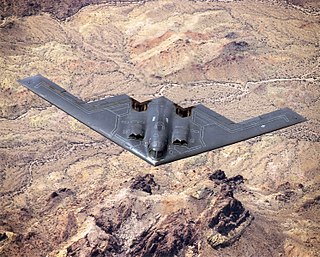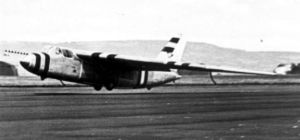Design and development
After extensive testing with wind-tunnel and flutter models, the design team proposed that a manned glider be built. [3] Shorts (Belfast) undertook construction on a single-seat glider incorporating the "aero-isoclinic" wing originated by Professor Hill. This radical wing configuration was designed to maintain a constant angle of incidence regardless of flexing, by placing the torsion box well back in the wing so that the air loads, acting in the region of the quarter-chord line, have a considerable moment arm about it. The torsional instability and tip stalling characteristics of conventional swept wings were recognised at the time, together with their tendency to aileron-reversal and flutter at high speed. It was to prevent these effects that the aero-isoclinic wing was designed.
The SB.1 glider was designed to be an inexpensive, simple machine, constructed primarily of spruce with reinforced sections using light alloy steel. The all-important wing controls had "elevons" pivoted on long, tapered light-alloy tubes extending from the leading edge of the tip, just inside the fixed part of the wing (illustrated by photographs in the Short SB.4 Sherpa article). The pivoting mechanism had a double-ball bearing unit on the inboard end with main loads transferred to a needle roller bearing at the outboard end of the fixed wing. Anti-balance tabs were fitted along trailing edges along with small pneumatically actuated flaps under the inboard sections. When the elevons were rotated in the same direction they functioned as elevators; when rotated in opposite directions they functioned as ailerons.
Testing
After final construction at Aldersgrove, the Shorts SB.1 bearing Class B registration G-14-5 was readied for flight testing early July 1951. For the first flight on 14 July 1951, the SB1 was winch-launched and the gliding characteristics were found by Shorts' Chief Test Pilot Tom Brooke-Smith ("Brookie") to be satisfactory.
A further successful test flight on 15 July 1951 was followed by the first towed launch from RAF Aldergrove on 30 July 1951. The SB.1 was towed behind a Short Sturgeon TT2 (VR363) piloted by "Jock" Eassie to a height of 10,000 ft, the height of the release. Although Brooke-Smith experienced turbulence inherent in flying a light aircraft in the wake of the towing aircraft, the subsequent test flight was completed successfully. During the second flight of the day (using a longer towline intended to alleviate the turbulence), the test pilot encountered severe buffeting problems and he had to cast off at low altitude. The flight ended catastrophically when Brooke-Smith attempted to side-slip out of the wake and struck the ground "nose-down" at 90 mph, injuring himself seriously and heavily damaging the aircraft.
During his recovery, Brooke-Smith expressed concerns about the towed launches and was adamant that testing the SB.1 required a new approach. The Shorts company persevered with the project, redesigning the aircraft six months later. The new design retained the wings and tail of the SB.1 but (at Tom Brooke-Smith's insistence) featured two small turbojet engines housed in a new, light-alloy fuselage. The result was the Short SB.4 Sherpa.

A flying wing is a tailless fixed-wing aircraft that has no definite fuselage, with its crew, payload, fuel, and equipment housed inside the main wing structure. A flying wing may have various small protuberances such as pods, nacelles, blisters, booms, or vertical stabilizers.
Short Brothers plc, usually referred to as Shorts or Short, is an aerospace company based in Belfast, Northern Ireland. Shorts was founded in 1908 in London, and was the first company in the world to make production aeroplanes. It was particularly notable for its flying boat designs manufactured into the 1950s.

Elevons or tailerons are aircraft control surfaces that combine the functions of the elevator and the aileron, hence the name. They are frequently used on tailless aircraft such as flying wings. An elevon that is not part of the main wing, but instead is a separate tail surface, is a stabilator.

The Northrop X-4 Bantam was a prototype small twinjet aircraft manufactured by Northrop Corporation in 1948. It had no horizontal tail surfaces, depending instead on combined elevator and aileron control surfaces for control in pitch and roll attitudes, almost exactly in the manner of the similar-format, rocket-powered Messerschmitt Me 163 of Nazi Germany's Luftwaffe. Some aerodynamicists had proposed that eliminating the horizontal tail would also do away with stability problems at fast speeds resulting from the interaction of supersonic shock waves from the wings and the horizontal stabilizers. The idea had merit, but the flight control systems of that time prevented the X-4 from achieving any success.
The Handley Page HP.88 was a British research aircraft, built in the early 1950s for Handley Page to test the aerodynamics of the Victor crescent wing design, and was intended to be a scaled-down version of that aircraft.

The Northrop XP-79, USAAF project number MX-365, was an ambitious design for a flying wing fighter aircraft, designed by Northrop. It had several notable design features; among these, the pilot would operate the aircraft from a lying position, permitting the pilot to withstand much greater g-forces in the upward and downward direction with respect to the plane – and welded magnesium monocoque structure instead of riveted aluminum.
The Society of British Aerospace Companies, formerly Society of British Aircraft Constructors, known as SBAC, was the UK's national trade association representing companies supplying civil air transport, aerospace defence, homeland security and space. As of October 2009 SBAC merged with the Defence Manufacturers Association and the Association of Police and Public Security Suppliers to form the ADS Group.

The Armstrong Whitworth A.W.52 was an early flying wing aircraft designed and produced by British aircraft manufacturer Armstrong Whitworth Aircraft.

The Short SA.4 Sperrin was a British jet bomber design of the early 1950s, built by Short Brothers and Harland of Belfast. It first flew in 1951. From the onset, the design had been viewed as a fall-back option in case the more advanced strategic bomber aircraft, then in development to equip the Royal Air Force's nuclear-armed V bomber force, experienced delays; the Sperrin was not put into production because these swept-wing designs, such as the Vickers Valiant, were by then available.
David Keith-Lucas was a British aeronautical engineer.

The Short SB.5 was a "highly unorthodox, adjustable wing" British research aircraft designed by Short Brothers in response to the UK Air Ministry requirement ER.100; to provide input for the design of the English Electric P.1 by testing the low speed flight characteristics of various configurations of wing-sweep required for supersonic flight. The tailplane could be mounted either on top of the fin ("T-tail") or below the fuselage. The tests ultimately confirmed that the original P.1/Lightning design was an effective configuration for high speed flight.

The Short SB.4 Sherpa was an experimental aircraft designed and produced by the British aircraft manufacturer Short Brothers. Only a single example was ever produced.

The Short Sturgeon was a planned British carrier-borne reconnaissance bomber whose development began during Second World War with the S.6/43 requirement for a high-performance torpedo bomber, which was later refined into the S.11/43 requirement which was won by the Sturgeon. With the end of the war in the Pacific production of the aircraft carriers from which the Sturgeon was intended to operate was suspended and the original reconnaissance bomber specification was cancelled.

Pterodactyl was the name given to a series of experimental tailless aircraft designs developed by G. T. R. Hill in the 1920s and early 1930s. Named after the genus Pterodactylus, a well-known type of Pterosaur commonly known as the pterodactyl, all but the first were produced by Westland Aircraft Ltd after Hill joined them.
Geoffrey Terence Roland Hill, was a British aviator and aeronautical engineer.

The SZD-6x Nietoperz was a single-seat tail-less experimental glider aircraft that was designed and built in Poland at Szybowcowy Zakład Doświadczalny in Bielsko-Biała in 1951. Only one example was constructed.

The Payen Pa 49 Katy was a small experimental French turbojet powered tailless aircraft, designed by Nicolas Roland Payen, and first flown in 1954. It was the first French aircraft of this kind and the smallest jet aircraft of its day.
The NRC tailless glider, also called the NRL tailless glider, was a two-seat tailless research glider designed by the National Research Council of Canada and built by the National Research Laboratories, at the instigation of G.T.R. Hill who had previously designed the British Westland-Hill Pterodactyl series of tailless aircraft.
The Tupolev ANT-41 was a prototype Soviet twin-engined torpedo-bomber of the 1930s. A single prototype was built, which was destroyed in a crash. No production followed, with the Ilyushin DB-3 serving as a torpedo bomber instead.

The Akaflieg Braunschweig SB-13 Arcus was an experimental tailless, single seat, Standard Class glider designed and built in Germany in the early 1990s. Though it performed as well as its conventional contemporaries, it did not offer sufficiently improved performance to compensate for its difficult handling characteristics.














